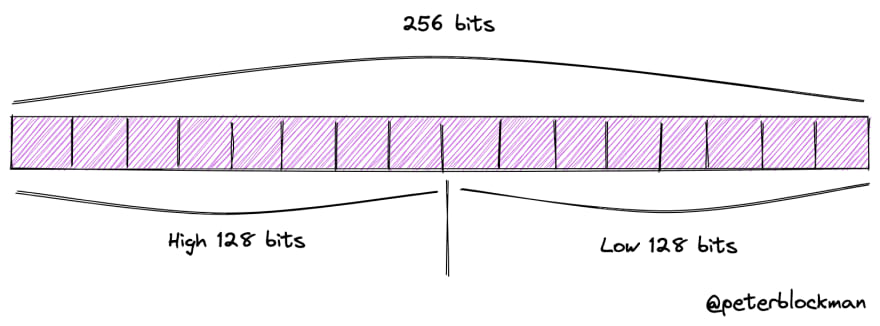Introduction
If you are confused about what value should be passed into the low and high of Uint256 in Cairo? you are not alone. I was confused the first time I saw it too. After digging into the code and asking around, I finally figured it out.
What is Cairo's Uint256?
Everything in Cairo is represented by felt. felt stands for Field Element, the only data type in Cairo. it is 251 bits unsigned integer.
Because a uint256 number has 256 bits in size, it can not be represented by a 251-bit felt. Therefore, it is necessary to split the uint256 number into two components: low and high. The low component represents the low 128 bits of the uint256 number, and the high component is the high 128 bits of the uint256 number. The binary value of low and high are padded with leading 0s up to the maximum resolution and put together side by side to form the uint256 number.
Uint256 is defined as a struct:
struct Uint256 {
low: felt,
high: felt,
}
Examples
For a better understanding, I have deployed a simple Cairo smart contract on testnet. The contract has only one view function get_uint256 that returns a Uint256 number in decimal from its low and high value.
@view
func get_uint256{syscall_ptr: felt*, pedersen_ptr: HashBuiltin*, range_check_ptr}(
low: felt, high: felt
) -> (num: Uint256) {
let num: Uint256 = Uint256(low, high);
return (num,);
}
Let's say we want to have number 4 as an Uint256. To do so, we pass 4 to low and 0 to high:
let num: Uint256 = Uint256(low = 4, high = 0)
4 is 100 and 0 is 0 in binary. We add padding zeros to them and stack them side by side, like so:
Let's check it on our smart contract:
What about Uint256(low = 0, high = 4)?
In the same token, we pad them with leading 0s to the maximum resolution and put them together:

That is 1361129467683753853853498429727072845824 in decimal. 👀
Conclusion
That's it for today. Thank you for reading this post, hopefully, it was useful. Let's keep on learning Cairo!
If you have any questions feel free to reach out to me on Twitter.







Top comments (4)
Spotted another small detail: In your opening paragraph, you state that
feltis 251 bit, whereas it should say 252 bit (at least according to the Cairo docs, here: cairo-lang.org/docs/hello_cairo/in...)Don't want to sound super picky about this - just wanted to point it out as I'm going through the learning journey and others might benefit from seeing this :) trying to pay close attention to all the material I read while I'm at it
Although P is a 252-bit number, dividing P by 2 would shift all the digits one place to the right. This makes P/2 have 251 binary digits. Therefore, felt is a 251-bit number.
Really helpful, thank you for this article!
Just a minor comment: on the second picture where you visualize
Uint256(low = 0, high = 4), they are put together the wrong way -0....0100should be on the left side. (You used the same picture as in the first example wherelow=4, high=0).Hey! Sorry for the late reply, I've been super busy lately. Thanks for pointing out those issues in the article. I've updated it now, so it should be all good. Keep on rockin' and learning! :)